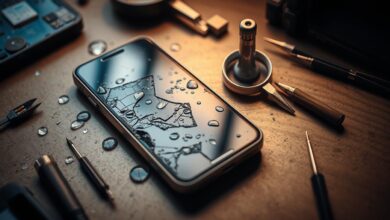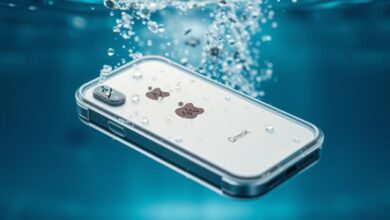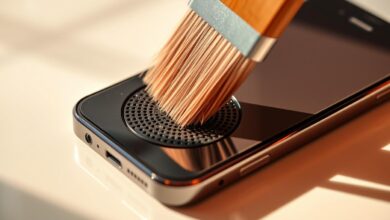Sound to Play to Get Water Out of Phone
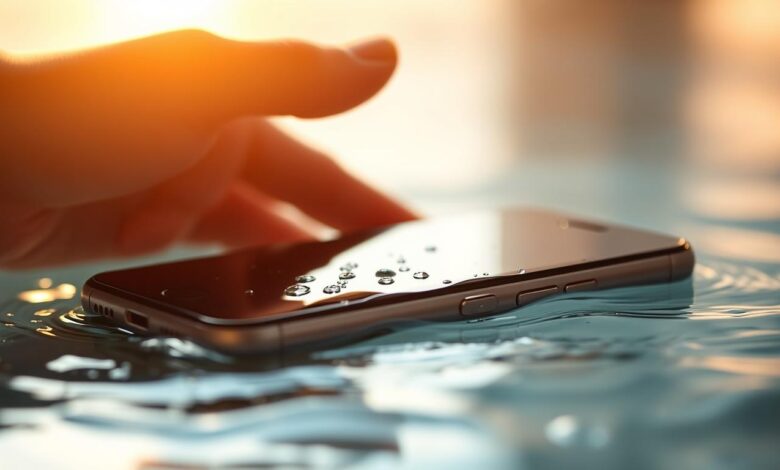
Water damage can make smartphones useless. When your device meets water, it can cause many issues. These include malfunctioning speakers and even system failure. Luckily, a specific sound frequency might help remove water from your device.
This method is a practical way to remove water from phone devices. By understanding the science and following the right steps, you might save your device from phone water damage.
Key Takeaways
- Understanding the risks of water damage to smartphones
- The science behind using sound waves for water removal
- Practical steps to safely remove water from your phone
- Precautions to prevent further damage
- Potential outcomes and limitations of the sound-based method
Understanding the Problem: Water Damage in Smartphones
Water damage in smartphones is a big problem. It can mess up how your phone works and how you use it. Knowing why it happens and how to spot it is key to fixing it.
Common Causes of Water Damage
There are many reasons why smartphones get water damage. Some common ones include:
- Accidental drops into water bodies such as pools, sinks, or toilets.
- Exposure to rain or being caught in a storm without adequate protection.
- Spills or splashes from liquids, including water, onto the device.
These situations can let water get into your phone. This can harm its inside parts.
Signs Your Phone Has Water Damage
Spotting water damage early is important. It helps you act fast to lessen the harm. Here are some signs your phone might have water damage:
- Malfunctioning speakers or distorted sound output.
- Corrosion or rust visible on the phone’s ports or SIM card slot.
- The presence of water indicators inside the device, which change color when exposed to water.
- Unresponsive or erratic touchscreen behavior.
| Signs | Description | Possible Outcome |
|---|---|---|
| Malfunctioning Speakers | Distorted sound or no sound | Speaker damage, requiring repair or replacement |
| Corrosion on Ports | Visible rust or corrosion | Port damage, potentially leading to connectivity issues |
| Water Indicators | Color change in water indicators | Indication of water ingress, potentially voiding warranty |
Knowing why water damage happens and how to spot it helps. Taking action early can save your phone. Also, keeping your phone clean and using protective cases can prevent water damage.
The Science Behind Sound Waves and Water
Sound waves can help get water out of phone speakers. This is based on a simple scientific principle. When a phone gets wet, water can get into the speaker grills and other openings, causing damage. Sound waves can push this water out, using the physical properties of sound and its interaction with water.
How Sound Waves Interact with Water
Sound waves are pressure waves that can move through air and water. When they hit water in a phone’s speaker, they can push it out by changing pressure. How well this works depends on the sound wave’s frequency and volume.
Research shows that some frequencies work better than others for getting water out. Lower frequency sounds have more energy and can push water out more effectively. But, the best frequency can change based on the phone’s design and how much water is there.
The Frequency Range That Works Best
Studies say that frequencies between 20 Hz and 200 Hz are best for getting water out. These low-frequency sounds can create big pressure changes to remove water from speakers. Here’s a table to show how different frequencies work:
| Frequency Range (Hz) | Effectiveness for Water Ejection |
|---|---|
| 20-50 | Highly Effective |
| 50-100 | Moderately Effective |
| 100-200 | Somewhat Effective |
| Above 200 | Less Effective |
For more info on using sound waves to get water out, check out https://www.wateroutofspeaker.com/. This site has useful tips and insights on safely removing water from your phone.
Sounds That Can Help Eject Water
Specific sound frequencies can help get water out of phone speakers. When water gets into your phone, it can trap in the speaker grills. This can mess up your sound quality. Using certain sound frequencies might save your phone from water damage.
Specific Frequencies Recommended
Studies show that some sound frequencies work better than others to remove water. Sounds between 100Hz to 200Hz are especially good. These low sounds can push out water without harming the speaker.
- 165Hz: This frequency is often recommended for its effectiveness in ejecting water.
- 180Hz: Another frequency that is commonly used for water removal.
Sample Audio Files to Try
If your phone’s speaker has water, try playing specific audio files. These files have the recommended frequencies. You can find them online or through phone water repair service providers.
Other Techniques to Remove Water
There are other ways to get water out of your phone too. Try gently shaking it or using desiccants like silica gel packets. Also, don’t charge your phone until it’s dry to avoid more damage. For serious water damage, getting a professional water damage restoration service might be best.
Here are some more tips:
- Use a soft cloth to gently pat your phone dry.
- Don’t use heat sources like hair dryers, as they can cause more harm.
- Put your phone in a dry place or use a dehumidifier to dry it faster.
How to Play Sounds on Your Phone
Playing the right sound on your phone can help eject water. Let’s explore how to do it.
Using Online Sound Generators
One simple way to play sounds on your phone is with online sound generators. These tools let you generate and play specific frequencies in your browser.
To use an online sound generator, follow these steps:
- Open a web browser on your phone.
- Search for “online sound generator” or “frequency generator.”
- Choose a reliable website, such as Online Tone Generator or Frequency Generator.
- Adjust the frequency to the recommended range (typically between 100 Hz to 200 Hz).
- Play the sound at a reasonable volume to avoid further damage.
Downloadable Apps for Sound Playback
If you prefer a dedicated solution, download apps for sound playback. These apps offer more features and better control over sound frequencies.
Some recommended apps include:
- Sound Frequency Generator: An app that allows you to generate a wide range of frequencies.
- Water Eject: An app specifically designed to help remove water from phones using sound waves.
When choosing an app, make sure it’s from a reputable developer and has positive reviews.
| Method | Pros | Cons |
|---|---|---|
| Online Sound Generators | Easy to access, no installation required | Dependent on internet connection, limited features |
| Downloadable Apps | More features, offline access, specific designs for water removal | Requires installation, potential for malware if not from trusted sources |
Safety Precautions Before Trying
To avoid more damage to your phone, knowing the right safety steps is key. When your phone gets wet, you must act fast to lessen the damage.
Avoiding Additional Damage
The first thing to do is turn off your phone right away. This stops short circuits that could hurt it more. Also, don’t charge your phone until it’s dry, as this can cause serious problems.
It’s also important to be gentle with your phone. Don’t shake or blow into it, as this can push water deeper into the phone’s parts.
Best Practices for Handling Your Phone
When dealing with a water-damaged phone, follow these best practices to avoid more damage. Here are some tips:
- Don’t dry your phone with a hair dryer or any heating device.
- Don’t use rice or other desiccants to dry your phone, as they can cause more harm than good.
- Gently pat the outside of your phone dry with a soft cloth.
- Remove any SIM cards, SD cards, or other external components to prevent damage.
To better understand what to do and what not to do with a water-damaged phone, here’s a comparison:
| Action | Recommended | Not Recommended |
|---|---|---|
| Immediate Action | Turn off the phone | Continue using the phone |
| Drying Method | Gently pat dry with a soft cloth | Use a hair dryer or heating device |
| External Components | Remove SIM cards and SD cards | Leave them in |
By following these safety tips and best practices, you can reduce the risk of more damage to your phone. This increases the chances of a successful phone water damage fix. If you’re not sure what to do, getting professional help for water damaged phone help is a good idea.
DIY Temperature Control Methods
If your phone got wet, you might try DIY temperature control. Using heat or cold is a common fix people try. It’s a way to rescue your phone from water damage.

Heat and Sound: A Dangerous Mix?
Using heat and sound together to dry your phone is risky. Heat can harm your phone’s parts if it’s already wet. Be careful with heat, as it might not work for all phones.
A hairdryer on low might seem safe, but it can push water deeper or damage parts. Think about the risks before trying it.
Alternatives to Sound Waves
Not sure about heat or sound? There are safer ways to fix water damage repair. Using desiccants or silica gel can soak up moisture. It’s a safe and effective method if done right.
Another option is cold temperatures. Some people put their phone in rice or a cool, dry place. But, this method might not work for everyone, and there’s a chance of corrosion if not dried well.
If you want a professional fix, think about a phone water repair service. They have the skills and tools to fix your phone right.
Myths About Removing Water from Phones
There’s a lot of wrong information out there about fixing a water-damaged phone. It’s important to know what really works to avoid making things worse.
Common Misconceptions
Some people think using a hair dryer or microwave can dry out a phone fast. But, these methods can actually harm your phone. The heat can damage the inside, and microwaves can even start a fire.
Another myth is that rice can magically pull water out of your phone. While rice can absorb moisture, it’s not as effective as thought. It can also fill your phone with dust and dirt.
What Really Works and What Doesn’t
So, what does work? Sound waves can help get water out of your phone’s speakers. Specific frequencies can safely remove water without harming your phone.
But, don’t try using a vacuum cleaner or compressed air. These can push water deeper into your phone or damage it with too much force.
“The key to successfully removing water from your phone is to act quickly and use the right techniques. Avoid methods that could potentially cause more damage.”
Not all methods are good for your phone. Knowing the best and safest ways to fix a water-damaged phone is crucial.
By knowing what works and what doesn’t, you can better save your phone. The goal is to get the water out without causing more harm. Using the right sound frequencies can help a lot in this process.
Professional Repair Options
Professional repair services can save your phone if it’s been wet. They offer a chance to fix it beyond what you can do yourself. Choosing to get help from experts can be very important for your phone’s future.
If your phone got really wet, knowing when to get help is key. Signs you need expert help include problems that keep coming back, corrosion, or if your phone stops working.
When to Seek Expert Help
Get professional help if DIY fixes don’t work or if you’re not sure about the damage. Experts can check your phone and tell you if it can be fixed.
Also, if your phone has important data you haven’t backed up, experts can try to get it back. This makes fixing your phone not just about the device, but also about your data.
Cost of Professional Recovery Services
The price for fixing a wet phone can change a lot. It depends on who you go to, how bad the damage is, and what kind of phone you have. Prices usually range from $50 to over $200, with more complex fixes costing more.
Always ask for a quote before you decide. Many repair services will check your phone for free. This way, you’ll know exactly how much it will cost to fix your phone.
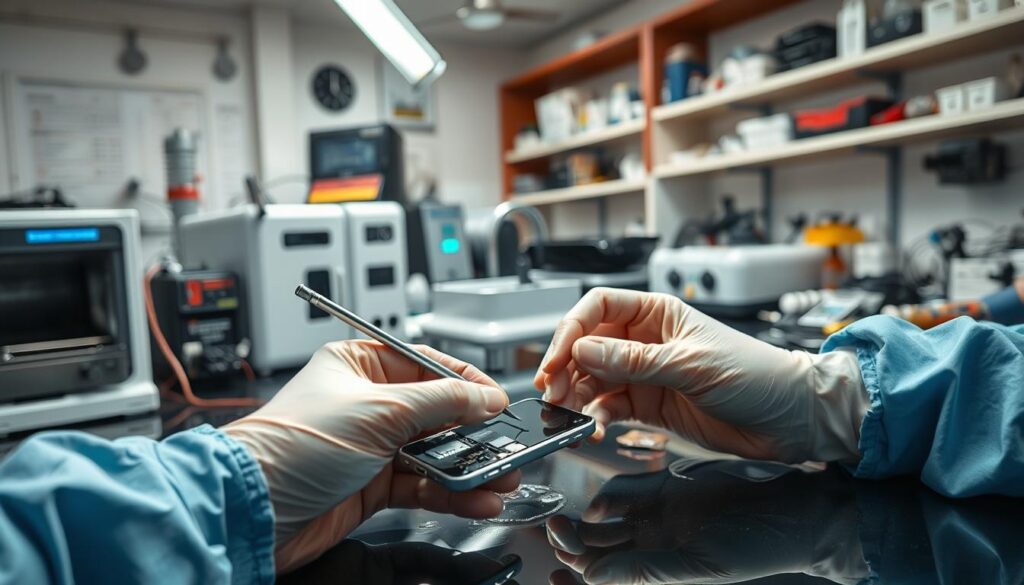
In summary, while DIY fixes work for small water problems, knowing when to get expert help is crucial. Understanding your options and the costs helps you make the best choice for your phone.
How to Prevent Future Water Damage
To avoid the hassle of water removal from phone, it’s key to take steps ahead. Keeping your device dry is vital, especially if you’re accident-prone or use your phone near water often.
Using protective cases and accessories is a smart move. They’re made to keep your phone safe from water.
Protective Cases and Accessories
Getting a top-notch waterproof case can greatly lower water damage risks. Brands like LifeProof and Catalyst make strong cases that protect against drops and water.
- Waterproof cases that seal your phone in a protective layer
- Screen protectors with oleophobic coatings to prevent water spots
- Port covers that shield your phone’s ports from water ingress
Tips for Safe Usage Near Water
Safe practices when using your phone near water can also help prevent damage.
- Keep your phone away from water when taking photos or videos.
- Don’t use your phone in humid places like bathrooms or during intense workouts.
- Be careful with your phone during outdoor activities like beach trips or pool parties.
By using the right accessories and being careful, you can lower water damage risks. This means you’ll need less phone water damage fix services.
These steps not only protect your device but also save you from repair hassle and costs.
User Experiences and Testimonials
People have mixed results when using sound waves to get water out of phones. Some say it works, while others warn of possible problems. It’s important to look at both the good and the bad to learn more.
Success Stories with Sound Waves
Many users have successfully used sound waves to dry their phones. For example, a YouTube video shows how a certain sound frequency helped remove water. This video is a great example of how this method can work.
Users have reported several benefits:
- Quick action: Fast responses often led to better results.
- Specific frequencies: Some sounds worked better than others.
- Combination with other methods: Mixing sound waves with other drying techniques improved results.

Cautionary Tales and Lessons Learned
Not everyone has had success with sound waves. Using them too loudly can harm the phone’s speaker. It’s key to know these risks and take steps to avoid them.
Important lessons include:
- Avoid using sound waves at maximum volume to prevent speaker damage.
- Be cautious of using this method with phones that have existing water damage symptoms.
- Understand that this method may not work for all types of water damage or phone models.
By looking at both the successes and the warnings, users can make better choices. This helps them decide if sound waves are right for their water-damaged phones.
Conclusion: The Best Sound Strategies for Phone Care
Using sound waves to get water out of your phone can work well if done right. Knowing how sound and water interact can help fix water damage on your phone.
Remember, certain sounds can push water out of your phone’s parts. I’ve talked about using online tools and apps to make these sounds.
Key Takeaways
It’s important to know the risks and limits of sound waves for water removal. Using sound methods with protective cases and accessories can lower water damage risks.
Staying Cautious
Be careful when trying sound waves to remove water. Watch your phone closely. If unsure, get professional help for water damage repair.
FAQ
What is the best sound frequency to get water out of my phone?
The best sound frequency for removing water from phones is between 165 Hz and 200 Hz. This range creates vibrations that help dislodge water from the phone’s speakers and openings.
Can I use any sound file to remove water from my phone?
You can try any sound file, but using frequencies between 165 Hz and 200 Hz is best. You can find these frequencies online or create them using tools or apps.
Will using sound to get water out of my phone damage it further?
Using sound waves to remove water is usually safe if done right. But, avoid loud volumes and wrong frequencies that could harm your phone’s speakers.
How long should I play the sound to remove water from my phone?
The time needed depends on the water amount and sound frequency. Playing the sound for a few minutes on a moderate volume is usually enough. But, don’t overdo it.
Are there any phone water damage repair services if the sound method doesn’t work?
Yes, if sound doesn’t work, you can get help from phone water damage repair services. They can fix or recover your phone, but costs vary based on damage and service.
Can I prevent water damage to my phone in the future?
Yes, you can prevent water damage. Use protective cases and accessories, be careful near water, and follow safe usage tips outdoors or in humid places.
What are the signs that my phone has water damage?
Signs include malfunctioning speakers, corroded ports, a non-responsive touchscreen, or the phone not turning on. If you see these after water exposure, your phone likely has water damage.
Is it safe to charge my phone after it has been exposed to water?
No, charging your phone right after water exposure is not safe. It can cause short circuits and more damage. First, try to dry it out or get professional help before charging.
Can I use DIY temperature control methods along with sound waves to remove water?
DIY temperature methods, like heat or cold, can be tried, but with caution. Mixing heat with sound waves is not recommended as it could damage your phone further. Always seek professional advice before trying such methods.
